So The new MF-1 has landed and turned out to be as expected not much more than a re-loadable disposable. It wasn’t awful at that job but how does it compare to some alternatives ? Time to turn out the plastic & single use cameras and fight it out !!!

The MF-1 at launch was belittled as being little more than a disposable. And whilst the criticism is right one can’t help the feeling that the company is being punished for not producing an iconic high end rangefinder. This is however the 21st century. The delay of building the Reflex SLR and the lack of backers for the Elbaflex SLR, illustrates the issues neatly. There’s the technical challenge of building a high end film camera as new start up and the bigger issue of getting people to buy them when you can literally pick a good SLR body for the price of a bottle of Irn Bru (or any soft drink of your choice).
Also this is pretty much the same idea as the Lomography simple use camera. You kinda don’t see folk venting there spleen about that…
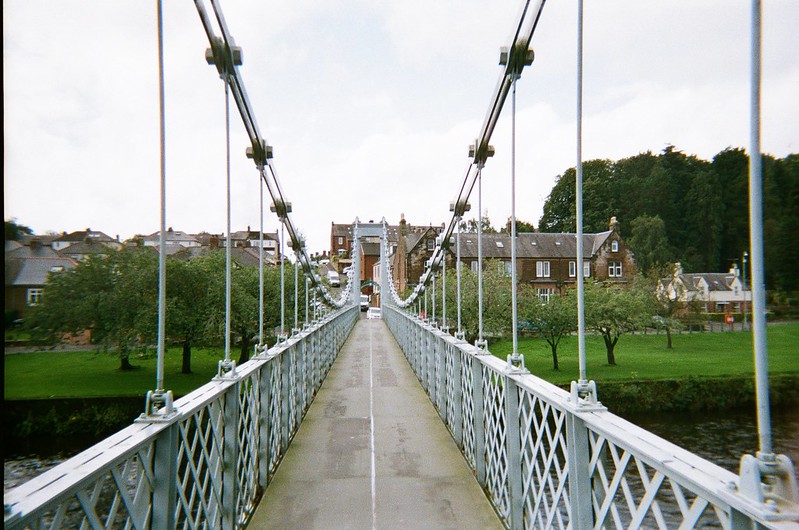
Still it is what it is so how does it compare to actual disposables and lo-fi cameras out there
The test pool
I ran it initially against just 2 cameras – a Kodak Fun saver single use and a Miranda Panorama solo (aka Halina Panorama). I also chucked in an Ilford XP2 single use midway through.

Worth nothing all the cameras have a curved film path.
The Ilford shots shown are taken the following day but in similar conditions. The 2 loadable cameras were loaded with fresh Kodak Ultramax 400 as both recommend 400ISO for optimal use. All films were processed and scanned by AG Photolab.
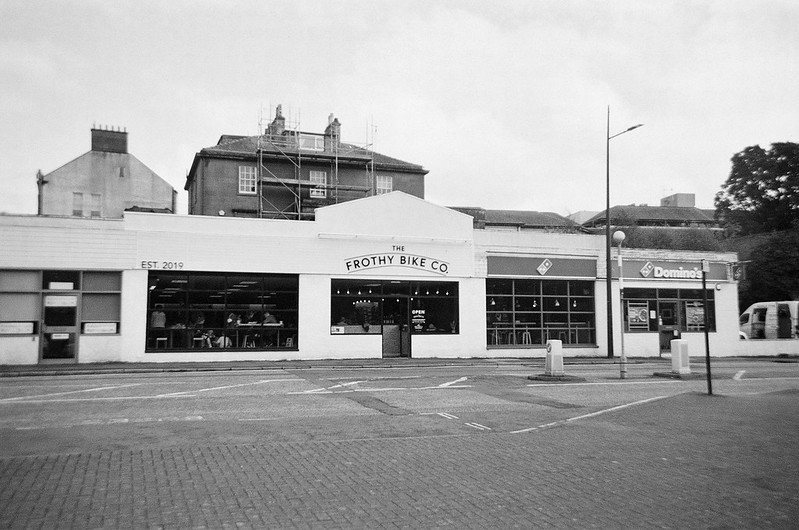
1. The New Upstart
Yashica MF-1 ~ £22.50 with film

I’ve bigger review of this but in essence it has a fixed focus 31mm 1:11 lens with fixed aperture and a single 1/120 shutter. It is reloadable and has a built in flash powered by a single AA battery. That battery was in the box along with a strap and roll of Yasica 400ISO colour film in the Kickstarter launch pack although we swapped it to Ultramax for this test.
2. The Hong Kong Slugger
Miranda Solo Panorama ~ 99p to a fiver on eBay
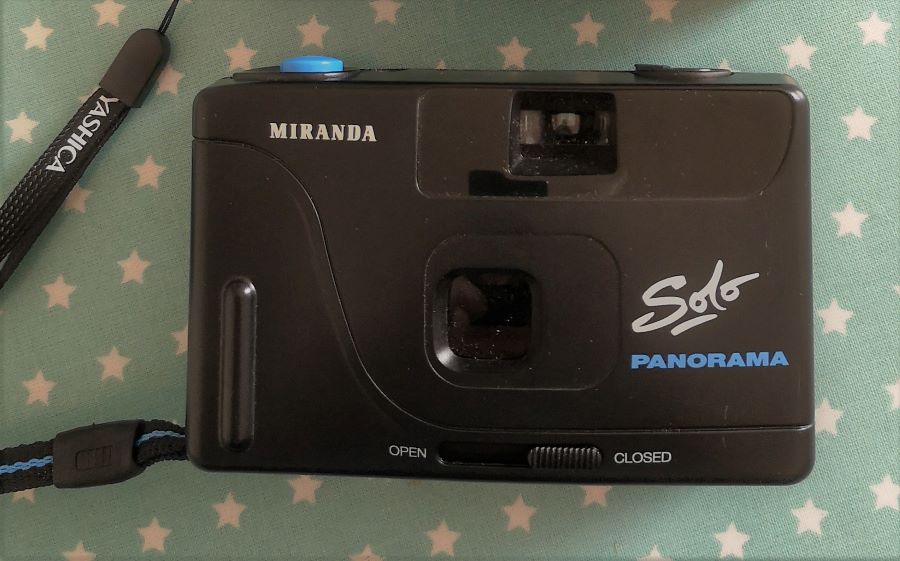
One of many rebrands of Haking’s Halina Panorama. So 28mm 1:11 shooter with a fixed aperture and shutter of 1/125. Should have strap and as buying second hand there’s a possibility you’ll get a naff case chucked in. Widely available online more commonly under Halina moniker or as the Ansco Pix wide in the US. The camera has a removable mask which frames for the panorama format (13x36mm). I’ve removed the mask on the test so we’re shooting full frame
No Flash on this one but the Halina Panorama F add that if you need it.
3. The Rochester King
Kodak Fun Share Disposable
(2 for £17.99 on Amazon)
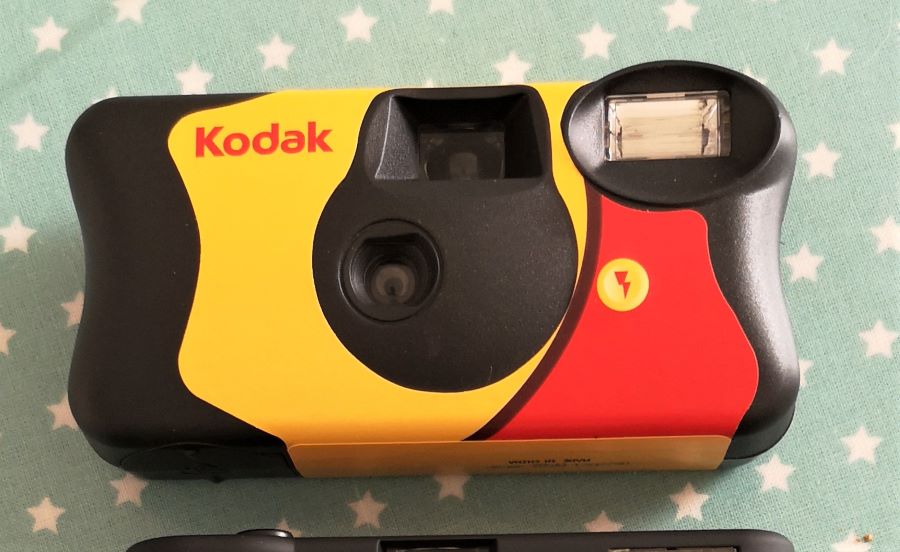
Not the cheapest disposable on the market but one of the best regarded. It also comes with 39exp compared to 27 on other single use cameras making it actually more cost effective. Has a 2 aspherical element plastic 30mm lens with fixed aperture (f/10) and 1/100 shutter. Pre loaded with Kodak Gold 800 ISO film. Casual Photophile has a good review.
4. The British Bulldog
Ilford Single Use XP2 Super £8.99 Boots.com
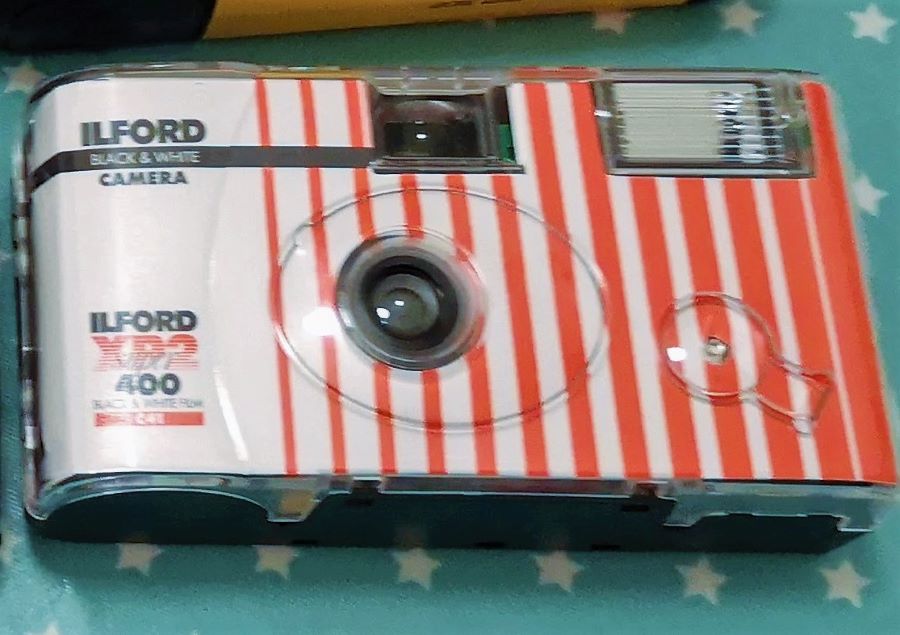
One of 2 Ilford single use cameras (the other loaded with HP5). This one uses C-41 process XP2 making the film processable in any lab. the usually found spec online is 30mm 1:9 lens with a shutter speed around 1/100. Daniel Schneider’s detailed review of the HP5 version suggests those numbers are more guess work. Still you get a 27 shot camera here. It’s likely the chassis is used in other single use cameras. Still it and its sister model are the highest rated B&W single use cameras in the Darkroom’s top 10 disposable list.
Round 1 Looks – Winner Yashica
Look no-one here is going to win a beauty competition. But the MF-2 wins out by being actually the most appealing in the launched Rubberised Black . At launch 11 rubberised colours were available plus the usual black plastic card sleeved version. It isn’t over logo’d a point that the worst looking on test the Ilford should have picked up on.
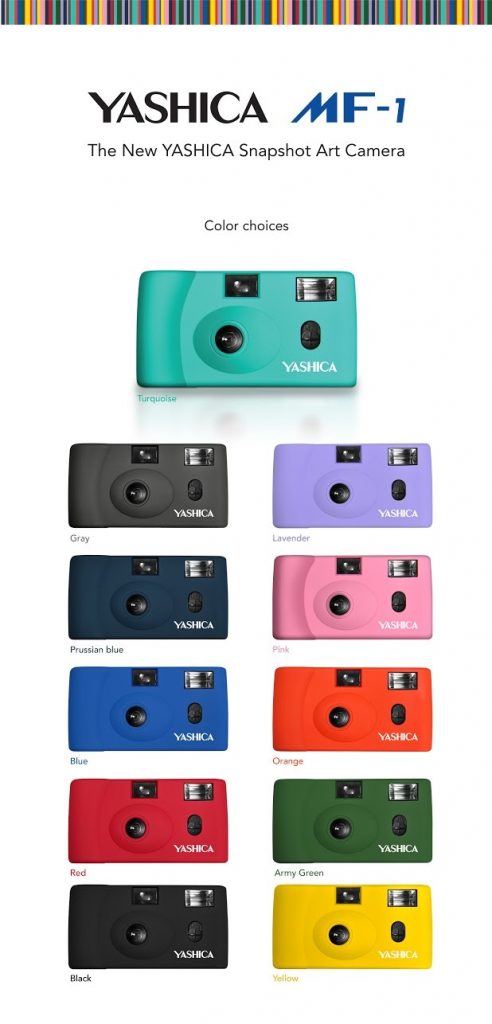
Oddly the Ilford is broadly a similar body design as the Yashica with the same elliptical mount around the lens. In fact if you spray painted it black it could be a draw. But nope someone chose to put a transparent front with a bright red & white turd of a design. You know you’re shooting XP2 from about 100 yards. Subtle it ain’t.

The Kodak is little better and I could live with the red yellow livery but Kodak decided that the end user really wanted a funky styled disposable resembling a kids toy. Unfortunately I’m not that end user.
The Miranda is a lump of shiny plastic but at least it isn’t too offensive with its logos and comes in at second place.
Round 2 – Build Quality – Winner Kodak
The Kodak is actually a well put together bit of kit. It feels the most robust on test and of the 2 single use cameras it is much easier (and safer) to tear down and rebuild.
I’m giving second to the Miranda. Hard shiny plastic it may be but it (and all the Halina Panoramas I’ve had) has survived use with at least 2 owners.
Third place is harder but the Ilford nudges it though. Although it is brittle plastic and will likely electrocute you if you try to reuse but for single use it’s tightly put together. The Yashica’s rubberised body feels robust but open the camera up and things feel more flimsy. The loading winder is disturbingly weak feeling and the door doesn’t always shut.
Round 3 Perks – Winner Miranda
I’m Ignoring flash here as there’s a Flash version of the Miranda widely available. It offers a sliding lens cover that doubles as a shutter lock. The camera also comes with a built in Panorama mask giving you a multiframe camera. Granted no film but you can buy one of these for a quid and get a roll of Porta 800 for less than it’s rivals.
It also usually comes with a strap which only the Yashica also offers. That gives it second place. The Yashica and the other 2 at least come with a battery and a film.

Round 4 Reloading – Winner Miranda
The miranda tops things here too. It is a normal camera with a standard loading and rewing system and is by far much easier to load and unload. In second place is the Yashica. So okay you can reload (and I’ve got 4 films including one 36exp through it) but it really feels pretty shaky.
The Yashica loads by you popping a roll of film and securing it on the take up drum. You then close the door and using a handle wind the film onto that take up drum. So when you shoot you gradually wind the film back into the 35mm cartridge just like other disposables.
Just a shame the door has a propensity not to shut properly. Worse still the loading winder is incredibly brittle and feels like it will snap at any second.
Flash – Argh Haaaa !!! Single use shock of the Universe
Meanwhile the other 2 are not meant to be reload nor their innards fiddled with but both work as the Yashica does by winding film back into the cassette. So both loose marks here. I’m not going to recommend you open either as there is a genuine risk of electrocution from these (and trust me it bloodly hurts). The Kodak however is more geared to this if you must and actually a lot afer than the Ilford which is much harder to open and is much, much more likely to electrocute you.
Still reload both I did and in fact the Kodak still sits on a shelf having been reloaded and shot 4 more times. The Ilford got chucked in the bin after one reload as I remembered the pain of unloading and reloading it. It also felt much weaker after reloading. But all that is for another post.
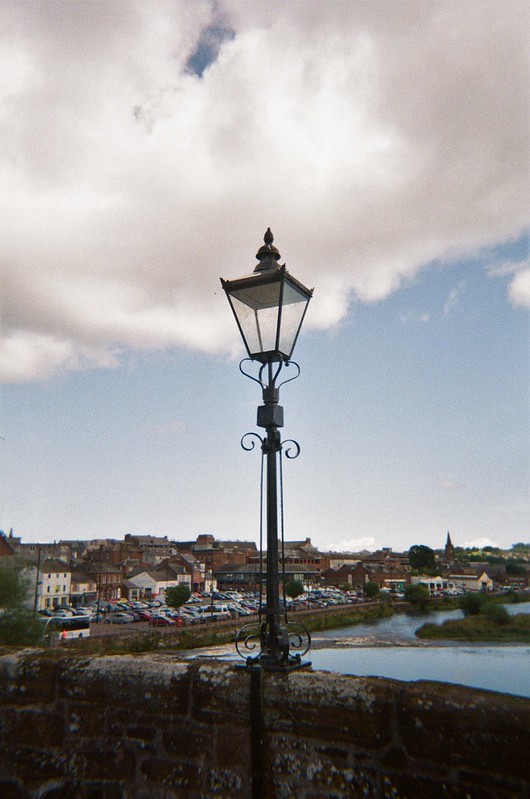
Round 4 Ease of Use – Miranda
All the cameras at some level are the same here but a few are noticable. The Miranda wins out despite not being the easiest to hold (that honour goes to the Yashica) and having a narrowed pan format viewfinder. It is because it does have the shutter lock and lens cover which are genuinely very useful and along with the Yashica the only cameras that can use a strap.
The yashica has the best grip thanks to the rubberised coating an handgrip but it’s let down by the spongy feeling winding. The Kodak has the best viewfinder and the Ilford trails as being the hardest to hold.
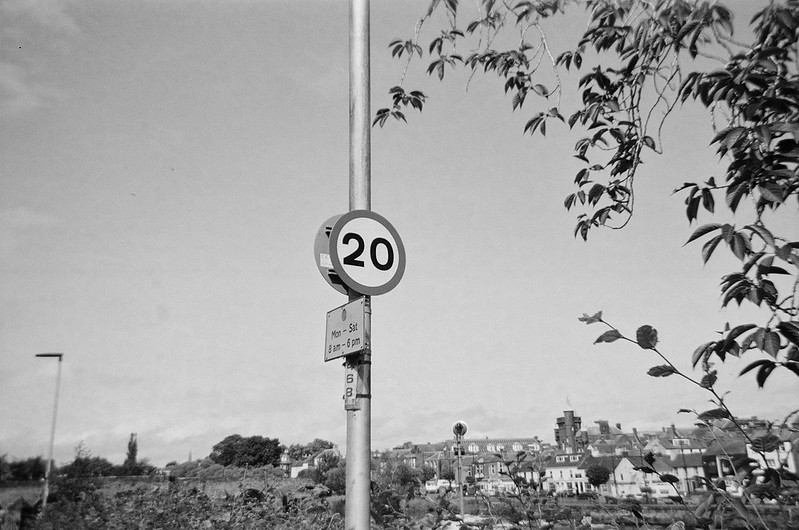
Round 5 Long term Cost – Miranda
The Miranda starts out cheapest and even though doesn’t come with film will still leave change for a roll of consumer 400 ISO. If you compare it to the MF-1 you’ll actually cover lab costs and a second roll of film. It is also the camera that will last the longest here and has no fuss with 36 exp.
Second place must go to the Yashica on the same basis but you’ll need to get to 3 or more rolls to start undercutting the Single use cameras in value. However it feels unlikely to last much more than the years warranty you get with it.
3rd place goes to the Kodak as it’s cheaper and if you’re crazy enough to reload it, the camera will last longer than the Ilford.
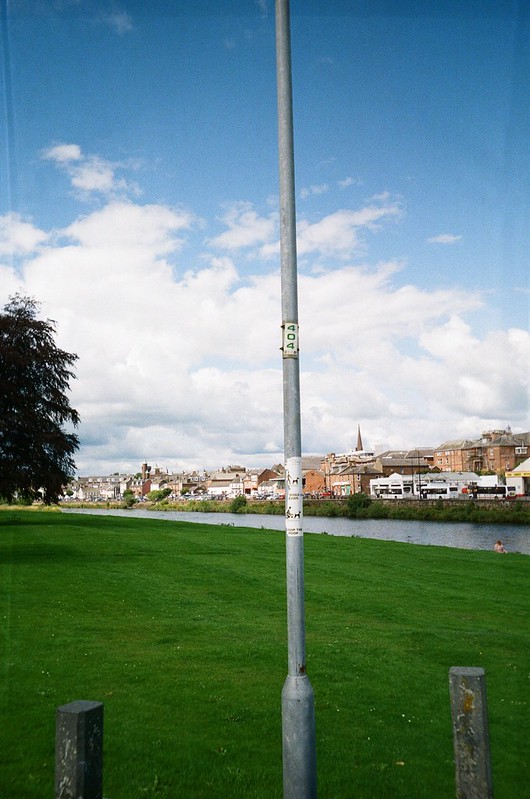
Rounds 6-10 Results – ?
So this actually turned out to be more interesting. All of these camera are optically flawed and fixed exposure. There is no dead causes here but no clear winners.
Comments I make here are relative. None of these cameras could be called sharp compared to any reasonable glass lensed cameras. Nor can they compete with the likes of the VUWS or Goko UF. But then again, they are superlatively lensed examples of plastic cameras. However, compared to many a plastic camera currently made with the lo-fi or lomography tag lines, these all give clinically better images.
Round 6 Exposure – Kodak (with preloaded film)
All have a fixed exposure geared for shooting in bright conditions but not all are equal.

Kodak has a trick. Unlike the others it isn’t preloaded with or recommends a 400ISO film. Nope, it’s comes with a 800 ISO Kodak Gold film. This has great latitude and a grain structure that makes it hard to tell apart from 400 ISO. It also keeps saturation high so in good light shots are pretty colourful.
The latitude is pretty incredible as even on bright days shots are not washed out. And you can go just that bit lower too.
Granted the Yashica and Miranda can pick the films they load but for out of the box use Kodak just nails it. Ilford Slips into 4th not that its worse than the others but it’s just pre loaded at 400 ISO with no choice. However XP2 is also a great film with good latitude and it shows. It is also the only widely available C-41 process B&W film you can buy.
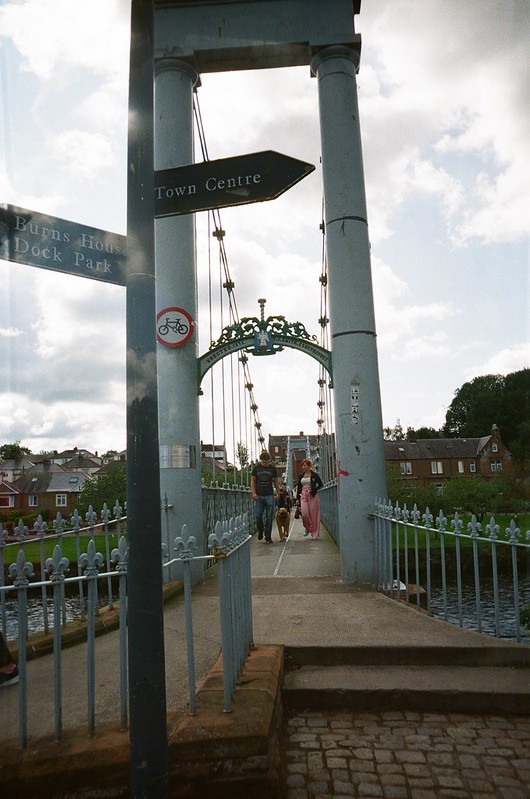
Round 7 Centering, Focus field and Distortion – Miranda
Given these all have simplistic plastic wide lenses, with a curved focal plane it isn’t a huge surprise to see they all distort similarly. All soften and fringe a bit towards the edges and show a degree of pincushion distortion. But it isn’t equal.

The garage door shot was used for testing and one camera kinda shone out. The Miranda had less distortion, softening and was much more on centre. But there is an issue for our winner. By removing the filter mask means curved aberrations appears on every image on the long sides. Worse still is the camera insides are shiny when you take out the mask (it’s matt). This means the camera can oddly reflect internally. The aberrations are easily dealt with by subtle cropping but the odd shot is ruined by the ghosting reflections
Beyond that It’s more of a Scrum. On closer shots the Kodak softening at the edges seems less than the others but on longer shots the Ilford wins out They all have broadly the same amount of radial distortions. However fringing is less of an issue on the Ilford but given it’s a B&W camera no big surprise. The Yashica trails but not by much
Round 8 Long Shots- Miranda

This should have been obvious. Haking built the panorama to take erm.. panoramas. It is by far the best long shooter in the pack. None of the other cameras come close and all leave long shots distinctly poor
Kodak does win a close tussle with Ilford for second place. It is better centrally although falls behind the Ilford on the edges . The Yashica lags behind both.
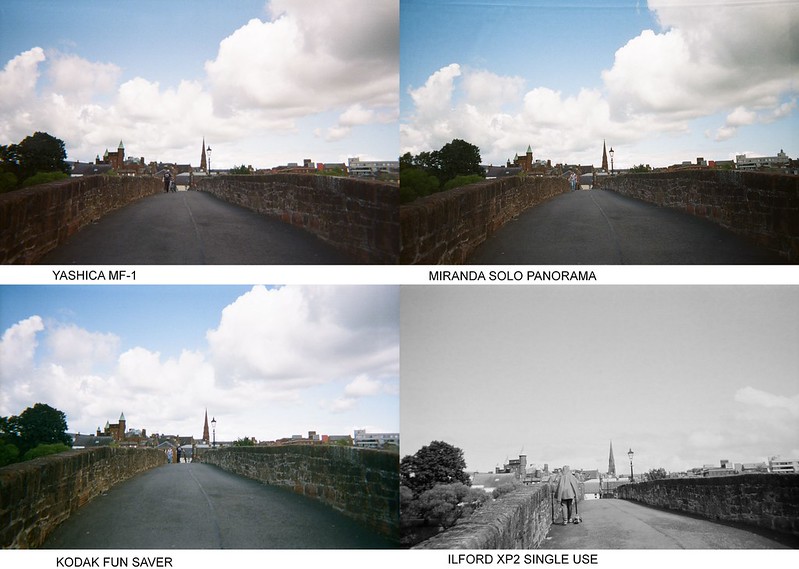
Round 9 Near Shots – Ilford
It may just the everything looks better in B&W but the Ilford looks better around the 1.5m mark. The Miranda just edges ahead of the Kodak, a remarkable feat given it’s geared towards landscapes. The Yashica trails again.

Round 10 Flash – Kodak
The Miranda is out here (although a Flash version exists at least with Halina branding).
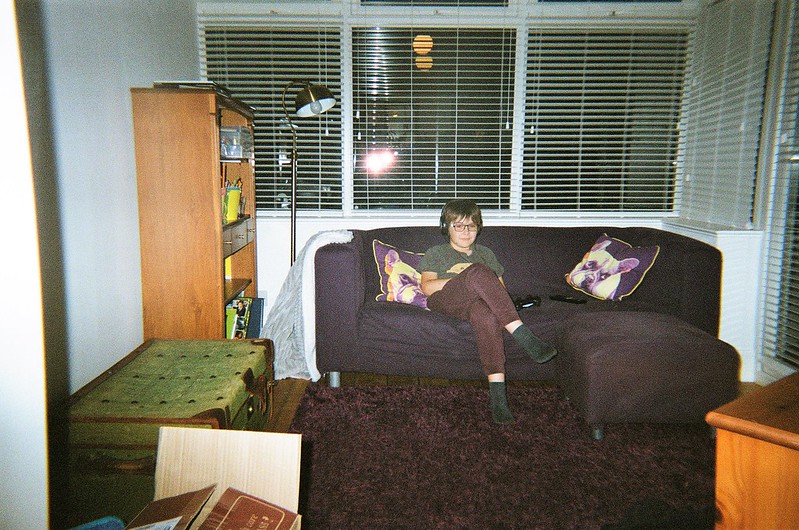
Kodak stormed a head here. the 3-4m flash shots came out much more usable than the others which were notably darker. probably the extra ISO speed but it makes the kodak a more enticing platfom for parties. There was little to seperate the Yashica and Ilford cameras but they may be based on similar parts
But why did you use…..
Why did I pick the Miranda. Well I wanted a cheap no control fixed focus camera. i’d ideal wanted something like a Halina Vision XF, Le Clic FS50 or the Flash version of a Halina Panorama. the point was a cheap flash shooter with similar spec to the MF-1 and the single use cameras. Now of course I’ve avoided glass lensed cameras (including the Yashica MF-2 Super which is fixed everything) as that’s unfair. equally the better plastic fantastic like the VUWS and Goko UF have been deliberately avoided.
Why the disposables used ? Well I had ’em and why not. Yup I could have picked up a no brand single use. I wanted to get a lomography simple use to compare but couldn’t get one in time (that’s a future showdown perhaps). But going in against the likes of Kodak are important.

Conclusions
None of these are great cameras. Nor is any an absolute donkey in comparison to the others and the Yashica can at least say it was in the race here. Indeed it was the best looking of the 4 cameras by some margin.
Just a shame about the build quality then. If you worry that your VUWS is gonna explode on winding then the MF-1 is not for you. the loading mechanism feels vulnerable especially the loading winder. Yes it is a hell of a lot easier to reload than the single use cameras but the Kodak felt more sturdy after being reloaded 4 times and that’s meant to be a single use camera.
So it comes in last but not by much.

3rd Place
The Ilford has it’s moments optically and is out of the box B&W. But it was the worst looking on test and worse it was designed by a sadist. Determined to stop Joe Pubic dissembling it and reloading it, the exposed wires for the flash capacitor sit just right on the edge of the case where you’d logically grab it. I really can’t recommend a camera that tries to tazer you, if you’re fool enough to dissemble it, as reusable. But a a single use camera for B&W it’s great and as a single use gives the Kodak a real run for the money.
2nd Place
The Kodak often has the accolade of being the best single use camera. It comes loaded with more shots, is better built, has better exposure range thanks to the brilliant 800 ISO film and is probably just better overall optically than all the cameras here bar our winner. It also if you must is much safer and easier to reload than the Ilford. Without doubt it is the best single use on test and if you must take the risk – easier to load than other single uses.
Winner
But in the end the clear winner is the Miranda (aka Halina Panorama). This black lump of plastic may not have the style of the others but it is optically that bit better. Granted you’ll have to factor in cropping off a few mm at the top of your full frame and be careful with flare. Of course you can stick in the mask and these things don’t matter

It is also the only camera that feels secure safe and easy to reload and is unlikely to kill or maim you whilst reloading (Ilford I’m looking at you here). It is also peanuts to buy.



7 thoughts on “Plastic Meltdown – A Yashica MF-1 Group Test Comparison”